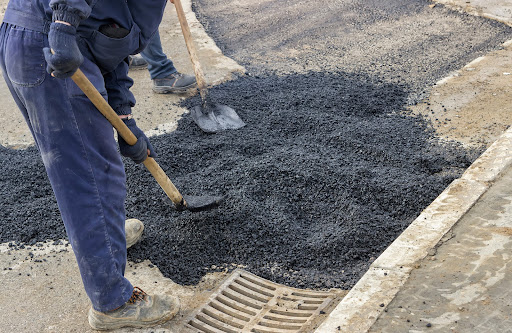
Potholes can be a pain to see and an even bigger pain to deal with. When your property experiences a pothole, it’s important to have it filled as soon as possible. But, what pothole filler should you use?
As its name suggests, a pothole filler is a material that is used to fill potholes. This material is usually poured or pressed into the gap on the ground to close the hole and make the surface even once more.
Pothole filling is paramount to any type of property. When potholes form on the ground, they can have adverse effects not only on the surface material but also on the business. Potholes are an eyesore and can drive away potential customers. They can also cause vehicle damage, and drivers don’t want to risk the hefty cost of repairs as a result of potholes.
In addition to losing business, potholes can also cause long-term damage. When left unaddressed, potholes can quickly expand and even multiply. They can compromise the integrity of the surrounding surface and cause premature degradation. In the end, property owners could face thousands of dollars in repairs.
There are several types of pothole fillers depending on the ground material. Roadways and parking lots, though, are commonly made of asphalt. And, for asphalt, there are two general types of pothole fillers: hot mix and cold mix.
Hot mix or hot patch is a type of pothole filler that consists primarily of aggregate and bitumen. It gets its name from the method of application, which involves heating the aggregate until it reaches at least 300°F before adding it to bitumen. This mixture is then poured into the pothole, and a heavy roller goes over it for compaction and hardening.
Many favor hot mix due to its durability. Because it’s heated before application, the hot mix is more pliable and sticks to the surface better. It also has a long shelf life, so you can buy a few bags without worrying about the mixture hardening in just a short period of time.
Of course, there are also drawbacks to this pothole filler. Hot mix requires special equipment that most commercial properties don’t have immediate access to. It’s also dangerous to use a hot mix if you have no prior experience with it.
Cold mix or cold patch is a type of pothole filler that consists primarily of emulsified asphalt, aggregate, and water. Unlike hot mix, the cold mix does not need to reach a high temperature or use heavy equipment. You can use it straight from the bag and apply it directly to the surface. These are the main benefits of cold mix asphalt.
That said, the cold mix also has its downsides. It is more affordable and easier to apply, but it does not have a very long shelf life compared to hot mix. If you don’t use it by the required time, cold mix asphalt will harden in the bag and become useless. It’s also not as durable as hot mix asphalt.
When it comes to determining the best pothole filler, the answer is relative. It ultimately depends on the material you are working with. For instance, driveways are generally made of concrete, so you will need a driveway hole filler. And the concrete mix is the go-to option for a driveway pothole patch.
As for asphalt pothole filler, it depends on what your needs are and how big the hole has gotten. You can typically use cold mix asphalt to fill cracks or minor potholes. It is a DIY-friendly material and often does not require the hands of professionals. But, if you have a big pothole to fill, hot mix asphalt is recommended.
Additionally, you should take durability and longevity into account. In addition to having a longer shelf life, hot mix asphalt also has a longer lifespan in use. When applied correctly and cared for properly, hot mix asphalt can last up to 25 years. In comparison, cold mix asphalt is only a temporary fix.
Potholes can bring all sorts of problems to your business or property. If nothing else, they are a huge inconvenience. As such, you would naturally want to have them filled and make the ground usable immediately. Unfortunately, a pothole patcher typically requires time to cure and harden.
The amount of time necessary to cure and harden will depend on the type of filler you use. Cold mix asphalt cures relatively quickly and solidifies within 3 to 4 hours. On the other hand, hot mix asphalt takes about 24 hours to cure and solidify. This is because hot mix asphalt goes on the surface at a high temperature, so it will take longer for it to harden.
But, slow-curing products are quite beneficial because they allow for better adherence. In contrast, fast-curing products often become rigid and hard to work with.
Many property owners will also want to apply a seal coat to finish the job. A seal coat is great because it provides added protection and durability. If you wish to use a seal coat, though, it is generally best to wait 24 to 48 hours after applying the pothole filler.
As you can see, pothole fillers come in a couple of options. When choosing the best one, it is important to identify your needs, assess the condition of the pothole, and consider all factors. Whichever one you go with, though, it is always better to hire a professional pothole repair company.
Professionals have more experience and access to the right products and equipment. When you take a DIY approach to pothole repair, you might end up doing more harm than good.
This is where Pothole Repair Carolinas comes in. We offer expert and competitive pothole repair services to residential and commercial properties in North and South Carolina. Call us today at 704-227-0468 or contact us online to get started!
RELATED ARTICLES: